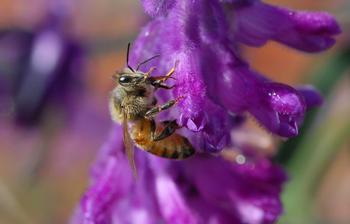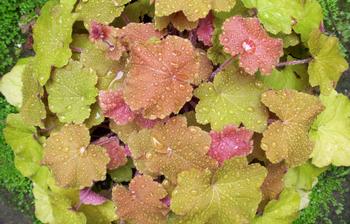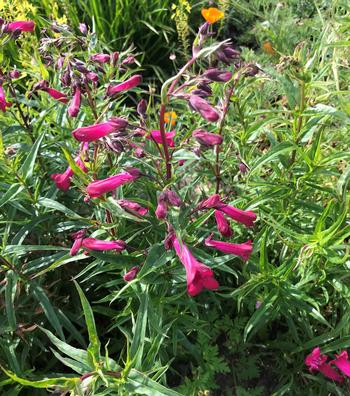Embrace low-water choices
-
Dot Zanotti Ingels
-
When we think of low-water, drought-tolerant plants, our minds often go straight to succulents. There are so many choices of succulents now that a case can be made that an attractive garden with colorful blooms is possible with succulents alone.
 Honey bee enjoying a tasty salvia bloom. Photo: Kathy Keatley Garvey from ANR repository
Honey bee enjoying a tasty salvia bloom. Photo: Kathy Keatley Garvey from ANR repositoryMarinites are good at many things; learning to save water in the garden is part of that list. Plants adapted to our long, dry summers and short, rainy winters are called Mediterranean climate zone plants. We share our climate with areas in Southern Europe, South America, southern Australia, and South Africa. These plants don’t need much water in the summer and have learned to thrive in water-scarce conditions over thousands of years. There are many choices for perennials, shrubs, ornamental grasses, trees, vines, turf, and ground covers.
We are looking for plants that are appropriate for our Marin climate and that may use less water than what is growing in the garden now, but we also want a garden that is pleasing to our eye. Spending time outdoors is a Marin given, so let’s explore how to match our visual and water-wise goals into a garden to love.
Now is the perfect time to make the plans for changes. Fall is the prime planting season for drought-tolerant plants. It allows the winter rains to water for us and gives the roots a good start at establishing themselves. Come spring, they are ready to go and grow. Many nurseries have fall sales, which helps with the budget. Huchera comes in a variety of foliage colors and is easy to divide at this time of year. Photo: Creative Commons Vilachan
Huchera comes in a variety of foliage colors and is easy to divide at this time of year. Photo: Creative Commons VilachanLike establishing any plant, you cannot just put drought-tolerant plants in the soil and walk away. It takes about six months of consistent, deep watering to help the roots dig themselves far into the ground where the soil is cooler, and they are more apt to find more stored water than at the surface. When necessary, watering deeply once a week creates a deep wet zone where the roots are the safest. Always mulch around the new plantings to discourage weeds, keep the soil cooler, and help with moisture retention. Once they are settled into their new home, most of these plants can live with infrequent watering. This is especially true in the cooler months. You will still need to give them water when the temperatures are particularly hot and dry. Once the plants are mature and well-established, they will require little or no watering beyond winter rains. Too much water can harm some native plants.
California native plants are always a good place to start. They have learned to adapt and thrive where they are living. With vibrant flowers and various textures, shapes, and sizes, adding California native plants can make your landscape beautiful while supporting pollinators. The blooms make lovely additions to a vase in the house, too. Penstemon, or beardtongue, is a beautiful low-water flower with many colors to choose from. This variety is found in Harvey's Garden in Tiburon.
Penstemon, or beardtongue, is a beautiful low-water flower with many colors to choose from. This variety is found in Harvey's Garden in Tiburon.A great place to start is with plants in the sage (Salvia) family. Salvias come in a variety of sizes, textures, and amazing colors. They are hummingbird magnets, and the birds love the seeds. They like full sun. Another easy win is beardtongue (Penstemon). Again, there are a variety of sizes and colors. Yarrow (Achillea) is a landing pad for pollinators that like a flat place to eat—so many choices to explore. Coral bells (Heuchera) have beautiful foliage and sweet flowers.
The Marin Master Gardener website has lots of information on water-wise plantings, as does the Marin Chapter of the Native Plant Society. At both sites, you will find plant lists, book suggestions, and learning opportunities at lectures and hikes.



